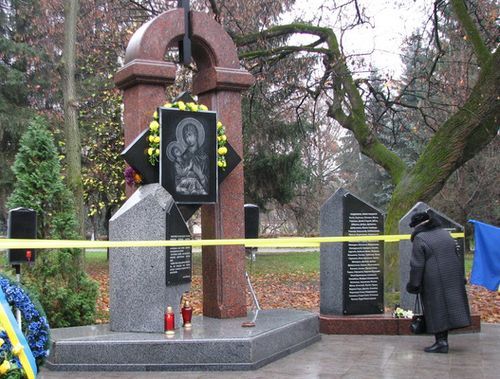A memorial to the deported Ukrainians sanctified in Lutsk

Zabuzhia, Smolyhiv, Dibrova, Zhabche, Oshchiv, Pidhaitsi... How familiar are these village names, inscribed on a modest stele! Villages with these names still exist in the modern Volyn region, as if giving a new lease of life to the Ukrainian settlements that had stood on the soil, now belonging to another state, since the beginning of time, as the saying goes...
“After all, it was the same people, descended from a Slavic tribe that settled on both banks of the Bug River. Hence the same names often given to villages both in what is now Volyn region and in the contemporary Poland,” head of the Kholm Land Regional Civic and Cultural Society Mykola Onufriichuk explained the coincidences. “Every student of history knows that the territory that was destined to become part of another state had Orthodox churches built since Prince Volodymyr’s baptism of Rus’, but there were no Catholic churches there before the 14th century...”
Inscribed on the deported Ukrainians commemorative stele are the names of 213 villages of Kholm Land, Podlachia, San Land, Western Boiko Land, and Lemko Land. They are purely Slavic, these names, such as Pasika, Striltsi, Tykhobizh, Dobromyrychi, Dubova Koloda, or Tuhani... Many of these villages have vanished or had their names changed. By a stroke of historical misfortune, this Ukrainian-populated country has suffered several mass deportations. More than 300,000 people were evicted from their ancestral land during World War I, and a third of them never returned. Then came ethnic violence, starting in 1943, and finally, Operation Vistula completed cleansing of Ukrainians from the trans-Bug districts.
“Many former Kholmans, Podlachians, and natives of other districts affected by deportations are now living in Volyn. People moved here to be closer to their homeland, but the border stands between it and them. People grow old and die, unable to even take a look at the place where their native village once stood. So a few years ago, we established a memorial for the deported Ukrainians, giving their offspring a place to come, pray, and honor their ancestors’ memory,” Onufriichuk said. “The latest additions to the stele are the names of burned and destroyed villages. Even now, not all places hit by that fratricidal war have been listed... The stele inscription reads: ‘In memory of the Ukrainians from Kholm Land, Podlachia, San Land, Western Boiko Land, and Lemko Land, who were killed or tortured to death by Polish armed underground, as well as those deported from their ancestral lands.’ These horrors did happen... Still, the inscription continues with striking words: ‘...and memory of those godly Poles who rescued their Ukrainian brethren.’ Polish authors have long been writing and broadcasting stories of Poles rescued by Ukrainians during ethnic cleansings in the 1940s, while in Ukraine, this theme, the theme of Christian charity, has still that feeling of something not quite legal... Before those events, we lived with the Poles in same villages, they were our neighbors and brethren. Although, of course, these were Ukrainian villages: for example, my ancestral Putkovychi, in Kholm county, had just five Polish families. We sheltered them when threatened, and they responded in kind when it was us who were in danger... We even left our house to them when we were being deported, because how much could one take on a cart?... We should know history, whatever it may be, for without that knowledge, there can be neither a true patriot, nor a simple God-fearing person.”






